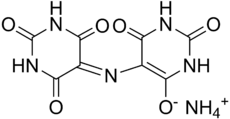Murexide
 | |
| Names | |
|---|---|
| IUPAC name
Ammonium 2,6-dioxo-5-[(2,4,6-trioxo-5-hexahydropyrimidinylidene)amino]-3H-pyrimidin-4-olate | |
| Other names
Purpuric acid ammonium salt | |
| Identifiers | |
| 3051-09-0 6032-80-0 (hydrate) | |
| 3D model (Jmol) | Interactive image |
| ChemSpider | 17264 |
| ECHA InfoCard | 100.019.334 |
| PubChem | 18275 |
| |
| |
| Properties | |
| C8H8N6O6 | |
| Molar mass | 284.19 g·mol−1 |
| Hazards | |
| R-phrases | R20 R21 R22 |
| Except where otherwise noted, data are given for materials in their standard state (at 25 °C [77 °F], 100 kPa). | |
| | |
| Infobox references | |
Murexide (NH4C8H4N5O6, or C8H5N5O6·NH3), also called ammonium purpurate or MX, is the ammonium salt of purpuric acid. It may be prepared by heating alloxantin in ammonia gas to 100 °C, or by boiling uramil (5-aminobarbituric acid) with mercury oxide. W.N. Hartley[1] found considerable difficulty in obtaining specimens of murexide sufficiently pure to give concordant results when examined by means of their absorption spectra, and consequently devised a new method of preparation for murexide. In this process alloxantin is dissolved in a large excess of boiling absolute alcohol, and dry ammonia gas is passed into the solution for about three hours. The solution is then filtered from the precipitated murexide, which is washed with absolute alcohol and dried. The salt obtained in this way is in the anhydrous state. It may also be prepared by digesting alloxan with alcoholic ammonia at about 78 °C; the purple solid so formed is easily soluble in water, and the solution produced is indistinguishable from one of murexide.
Murexide in its dry state has the appearance of a reddish purple powder, slightly soluble in water. In solution, its color ranges from yellow in strong acidic pH through reddish-purple in weakly acidic solutions to blue-purple in alkaline solutions. The pH for titration of calcium is 11.3.
Justus von Liebig and Friedrich Wöhler in Giessen, Germany, had investigated the purple product, murexide, obtained from snake excrement in the 1830s but this was not an abundant raw material and a method of using it as a dyestuff was not established at that time.[2] In the 1850s, French colorists and dye-producers, such as Depoully in Paris, succeeded in making murexide from abundant South American guano, and of applying it to natural fibers. It was then widely adopted in Britain, France and Germany.
Murexide is used in analytical chemistry as a complexometric indicator for complexometric titrations, most often of calcium ions, but also for Cu, Ni, Co, Th and rare earth metals. Cf. Eriochrome Black T. Due to the minute amounts needed for this purpose, it is often used in a 1:250 mixture with potassium sulfate.
Murexide is also used as a colorimetric reagent for measurement of calcium and rare earth metals; for calcium, the pH required is 11.3, detection range lies between 0.2 and 1.2 ppm, and the maximum absorbance wavelength is 506 nm.
Murexide and methyl red are investigated as promising enhancers of sonochemical destruction of chlorinated hydrocarbon pollutants.
References
- ↑ Some information on the chemist Walter Noel Hartley is available here
- ↑ Peter J. T. Morris & Anthony S. Travis (November 1992), "A History of the International Dyestuff Industry", American Dyestuff Reporter, 81 (11)
![]() This article incorporates text from a publication now in the public domain: Chisholm, Hugh, ed. (1911). "Murexide". Encyclopædia Britannica. 19 (11th ed.). Cambridge University Press. p. 36.
This article incorporates text from a publication now in the public domain: Chisholm, Hugh, ed. (1911). "Murexide". Encyclopædia Britannica. 19 (11th ed.). Cambridge University Press. p. 36.